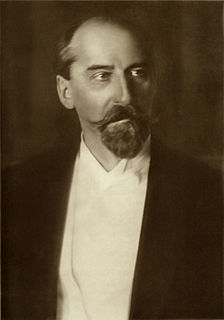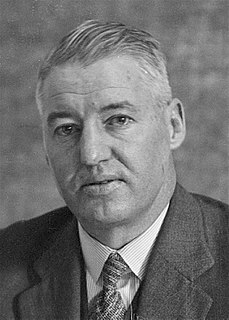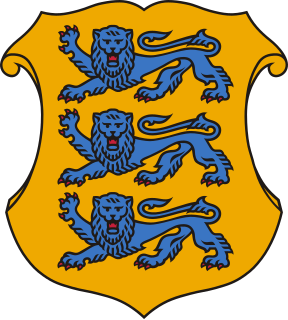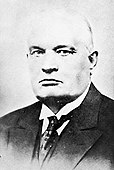The D'Hondt method or the Jefferson method is a highest averages method for allocating seats, and is thus a type of party-list proportional representation. The method described is named in the United States after Thomas Jefferson, who introduced the method for proportional allocation of seats in the United States House of Representatives in 1791, and in Europe after Belgian mathematician Victor D'Hondt, who described it in 1878 for proportional allocation of parliamentary seats to the parties. There are two forms: closed list and an open list.
Otto August Strandman was an Estonian politician, who served as Prime Minister (1919) and State Elder of Estonia (1929–1931). He was one of the leaders of the centre-left Estonian Labour Party, that saw its biggest support after the 1919 and 1920 elections. Strandman was a key figure in composing the radical land reform law and the 1920 Constitution. He also served as Minister of Agriculture (1918–1919), Minister of Justice, Minister of Finance (1924), Minister of Foreign Affairs and Minister of War (1919). While he was in the office of Minister of Finance, he stabilized the economy and managed to avoid hyperinflation. Strandman was also the speaker of both the Estonian Provincial Assembly (1917–1918) and Riigikogu (1921). He was a diplomat, serving as an envoy in Warsaw (1927–1929), when he made contacts with Polish politicians, and in Paris (1933–1939). During the Soviet Occupation in 1941, Strandman was ordered to show up to the NKVD headquarters. Already knowing about his fate, he committed suicide in his home in Kadrina.

Elections in Kuwait are held for both the National Assembly and for the Municipality. Kuwait's constitution calls for elections to the unicameral National Assembly at a maximum interval of four years. Elections are held earlier if the Constitutional Court or Emir dissolve the parliament.

Jaan Tõnisson was an Estonian statesman, serving as the Prime Minister of Estonia twice during 1919 to 1920, as State Elder from 1927 to 1928 and in 1933, and as Foreign Minister of Estonia from 1931 to 1932.

Parliamentary elections were held in Estonia on 4 March 2007. It was the world's first nationwide vote where part of the voting was carried out in the form of remote electronic voting via the internet.

General elections were held in Italy on Sunday 25 May 1958, to select the Third Republican Parliament. The number of MPs to be elected was calculated upon the population's size for the last time.

Constitutional Assembly elections were held in the newly independent Republic of Montenegro on 10 September 2006. Prime Minister Milo Đukanović's Coalition for a European Montenegro, at whose core was the Democratic Party of Socialists, won 39 seats in the 81 seat parliament with the vote near fully counted. The opposition blocs together received 34 seats. There were 484,430 eligible voters.

Parliamentary elections were held in Estonia between 21 and 23 May 1932.
Parliamentary elections were held in Estonia between 11 and 13 May 1929.
Parliamentary elections were held in Estonia between 15 and 17 May 1926. Before the elections the electoral law was changed to create more stability by introducing a system of bonds and raising the electoral threshold to require a party to win a minimum of two seats.

Parliamentary elections were held in Estonia between 5 and 7 May 1923. There were some controversies - some lists, most remarkably Communist, were declared void before the elections because of electoral law violations, and the results gave Estonia its most fragmented parliament ever.

Elections were held in the Australian state of Queensland on 9 October 1920 to elect the 72 members of the state's Legislative Assembly. The Labor government was seeking its third term in office since the 1915 election. It was Premier Ted Theodore's first election.
The Estonian Labour Party was a political party in Estonia. It was formed in 1919 by a merger of the Radical Socialist Party and the Social Travaillist Party, and ceased to exist in 1932, when it merged with other centrist parties to form the National Centre Party. It was a member of government coalitions between 1919 and 1925, and again from 1927 until 1931.

The Farmers' Assemblies was a conservative political party in Estonia. Led by Konstantin Päts, it was the ruling party for most of the inter-war period.
The Christian People's Party was a political party in Estonia between 1919 and 1931.
The Central Committee of Tallinn Trade Unions was a political organisation in Estonia.
Aleksei Sorokin was an Estonian lawyer and politician. He was regarded as one of the leading representatives of the Russian minority in Estonia during the interwar period.

Parliamentary elections will be held in Estonia on 5 March 2023 to elect all 101 members of the Riigikogu.











